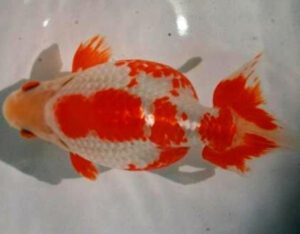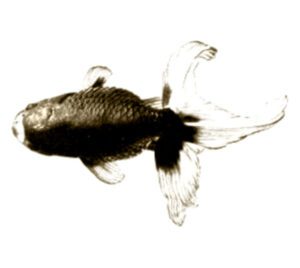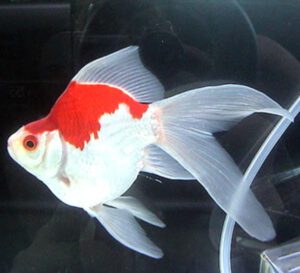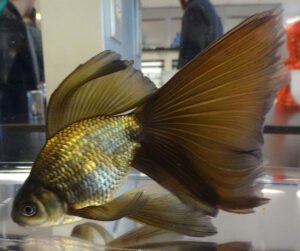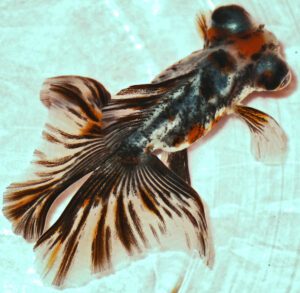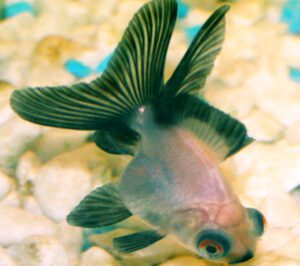The Celestial Eye goldfish is a fancy goldfish that has a breed-defining pair of telescope eyes which are turned upwards, pupils gazing skyward.
It is a double-tailed breed and also known as Choten Gan and Stargazer. These fish were first appeared as a direct mutation of the Telescope goldfish in the eighteenth century.
Competing traditions lay claim as to exactly where this happened first, Korea or China.
The first documentation that Celestials existed appears on a Chnese scroll of 1772, where a goldfish lacking a dorsal fin and possessing protuberant upturned eyes is depicted.
Until 1903 (when 30 specimens arrived from China and became the foundation stock for Japanese breeders), the Celestial Eye goldfish didn’t arrive in Japan. But Japan quickly became the leading producer of Celestial Eye goldfish for export.
After Second World War and ever since, the majority of the Celestial Eye goldfish exported from Asia are of Chinese origin.
And a Celestial is depicted on a postage stamp issued in 1960 by the People’s Republic of China. However, read some more information about this goldfish variety below.
Celestial Eye Goldfish Characteristics
The Celestial Eye goldfish are similar in appearance to the Bubble Eye Goldfish. They have an elongated egg-shaped body and they have no dorsal fin.
The caudal may be half as long, to as long as, the body. The paired fins are of the Fantail or Ryukin type.
In case of coloration, these fish are most commonly seen with metalic scales colored shades of orange, white or red and white.
They are also known with nacreous scales, but rare. They have normal eyes when young, but begin to protrude and the upturned versions develops.
Average body length of the mature Celestial Eye goldfish is about 5-6 inches. Photo and info from Wikipedia.
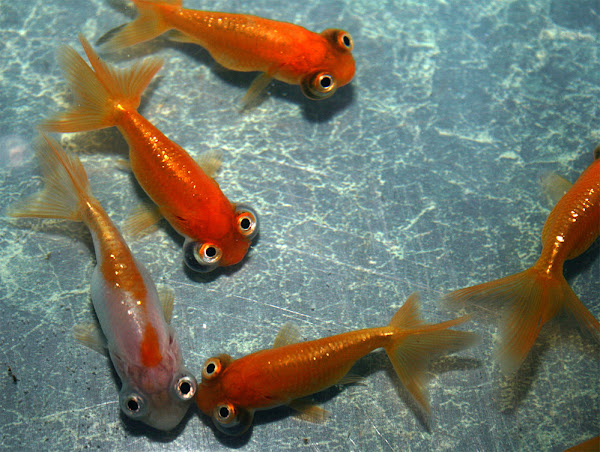
Diet
The Celestial Eye goldfish eat almost all kinds of foods. They may eat all kinds of frozen, fresh and flake foods.
Breeding
The male and female Celestial Eye goldfish are easily identified during the breeding season. Gill plates and pectoral fins of the male fish will develop white tubercles.
It is challenging for the males to locate the females, mainly because of their upturned eyes. So keeping numerous males in the tank for each female can help for breeding.
Keeping the breeding tank fairly bare is also wise. And also limit the availability of hiding places for the females.
Uses
The Celestial Eye goldfish are ornamental fish. They are mainly raised as pets.
Special Notes
The Celestial Eye goldfish are active and agile swimmers, despite their limited vision and lack of a dorsal fin.
They require special care and management, and not recommended for beginners. They are best kept with other limited-vision breeds or in tank of their own.
They have a lower tolerance to poor water quality than other goldfish varieties and is prone to disease.
Average lifespan of this goldfish is between 10 and 15 years. But sometimes they can even live longer. However, review full breed profile of these fish in the following table.
| Name | Celestial Eye Goldfish |
| Other Names | None |
| Breed Purpose | Ornamental, pet |
| Special Notes | Very beautiful, distinctive look, caring is pretty difficult, require very special care, active and agile swimmers, have no dorsal fin, not recommended for beginners, best kept with other limited-vision breeds, have a lower tolerance of poor quality water, raised for ornamental purpose |
| Size | 5-6 inches |
| Breeding Method | Artificial |
| Climate Tolerance | Almost all climates |
| Body Color | Many (orange, white, red and white) |
| Rarity | Common |
| Availability | Asia |

